What is Gold
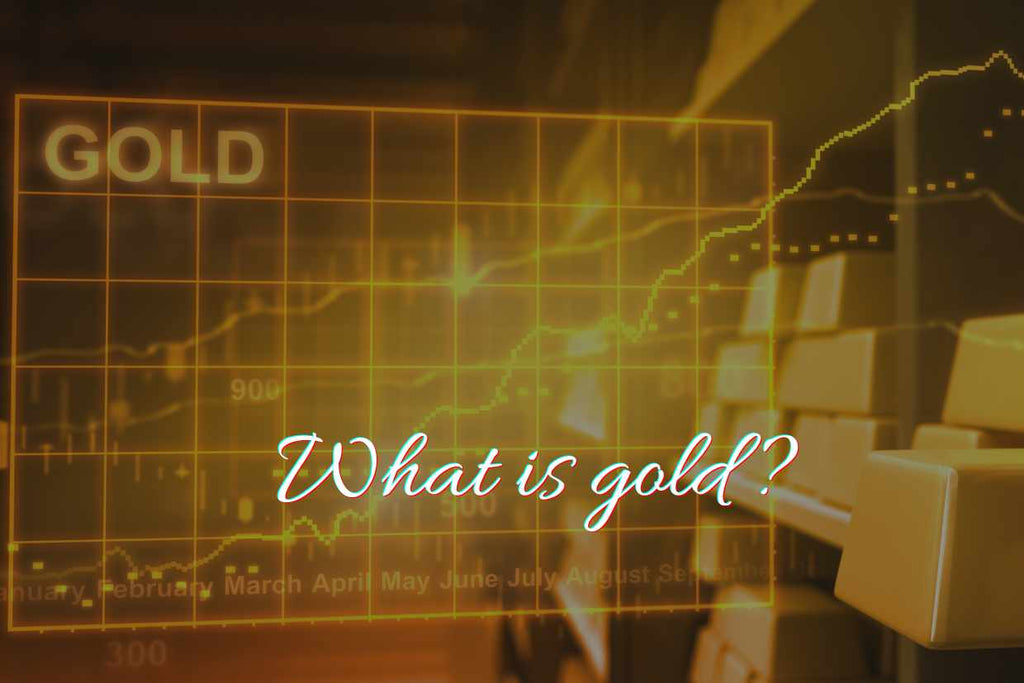
Everything you need know about Gold
They say all that glitter is not gold. Well, then, what is? The term gold is used quite often in speaking and writing, although interchangeably blurring its actual meaning.
You might have heard people say, "Oh, she has a heart of gold," referring to a kind soul and "This is gold!" implying something is priceless or valuable. Or you might be familiar with your favourite idols like BTS or Harry Styles, winning gold records for their high-selling albums.
Even for someone who has never seen or heard of the word, these phrases indicate that it is something that is commendable, valuable and desired. Whether you know little about it or know a lot about it, in this article, we will be exploring the precious metal that is widely talked about.
We will cover these areas to help you get a better and more in-depth understanding of the valuable one-of-a-kind metal. By the end of this article, you will know,
- What is gold in its natural form?
- How does it reach your hands?
- Why is gold so valuable?
- So what exactly is Karat?
- Real vs. Fake
- Culturally woven symbolism of gold
- Influence on the human psychological state
- Influence on the human physiological state
- What are the different types?
So let's get into the good stuff, shall we?
What is gold in its natural form?
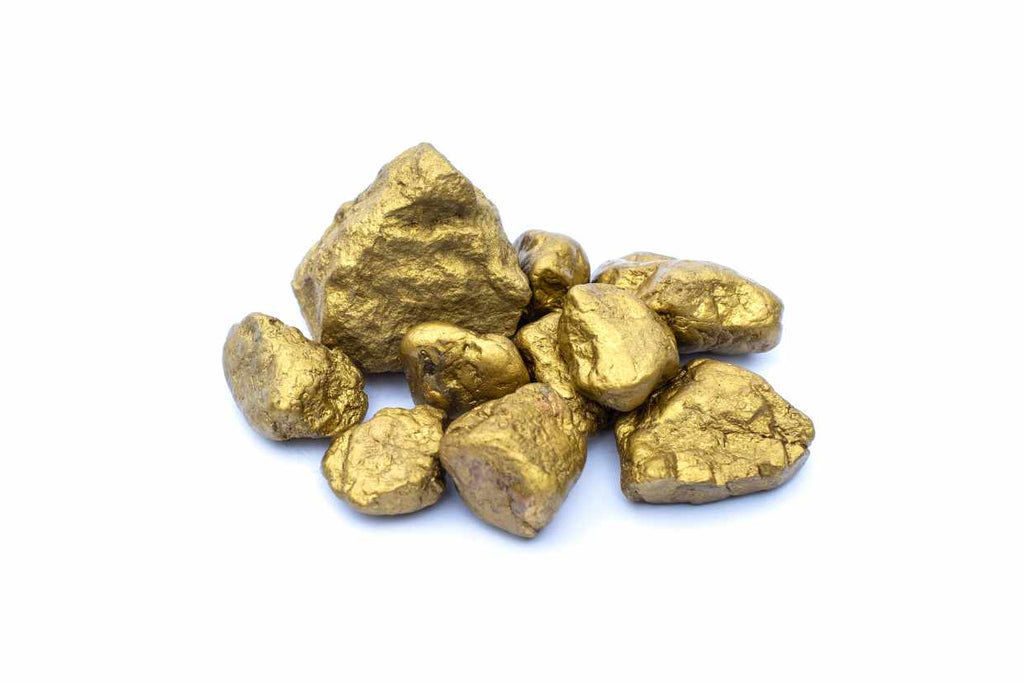
Everyone knows it in the form of pretty shiny jewellery, but what is it before that?
Descending from the Indo-European terminology, the word "ghel", meaning yellow, is the root of the common English word gold, given that metal's undeniable summer-like pigmentation, naming it after its colour is easily justifiable.
If you remember junior school science lessons, you would know that gold is within the period table, in the symbol Au signifying Aurum in Latin, as a non-reactive metal. Because of this, it has little to no effects from being exposed to most liquids, air and other forms of matter, which makes it the perfect material for body jewellery.
Although it is hard for archaeologists to exactly distinguish the first discovery, there are traces of evidence of the metal in caves as old as 40,000 BC. Since then, to date, about 244,000 metric tons of gold have been discovered on the earth.
In its natural form, it is mostly found as grains, streaks or nuggets; in particular, rock is a soft and malleable metal with its signature yellow tint. The distinctive atomic structure of this precious metal gives it the benefit of being easily manipulated, which paves multiple pathways to various uses we will be covering below.
When mined and processed, the metal transforms into an alloy with a noteworthy level of purity compared to the metallic alloy.
How does it come to your hands...
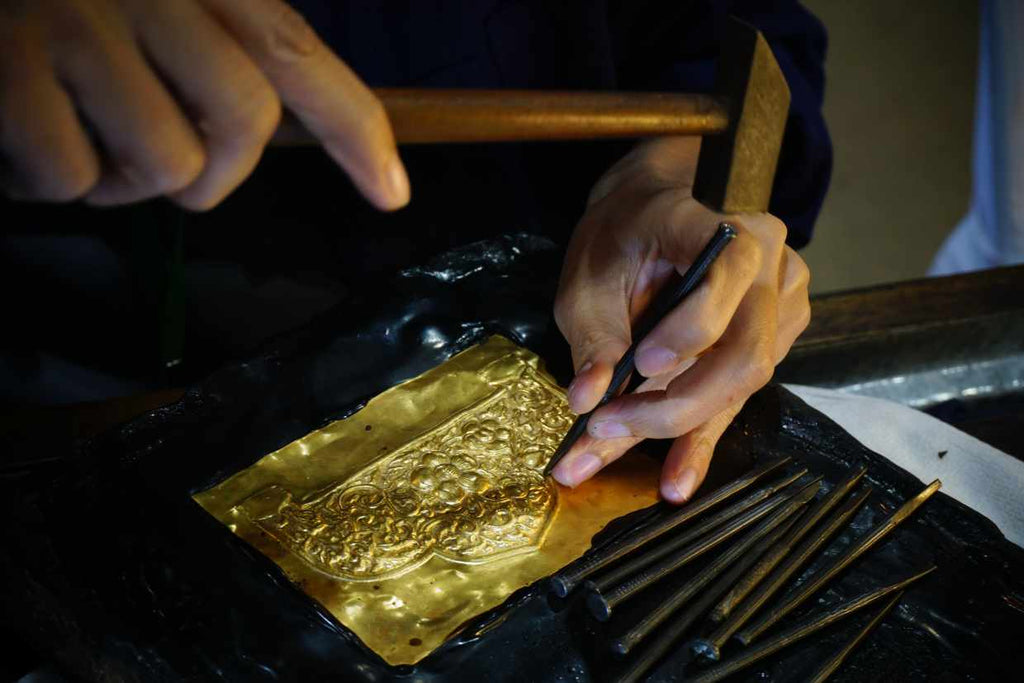
Gold jewellery would be as expensive as a bag of fruit in your local market if it reached your hands just as it was mined and processed. However, the rare metal undergoes a manufacturing process which amps its market value even more.
In the past, jewellery was all handmade from shaping, moulding and engraving designs or gemstones, which required tons of time, patience and human labour. Fortunately, nowadays, new technology has provided an opportunity for labour to be passed off to machines, which saves both time and human labour without a hassle. However, completely handmade jewellery is highly appreciated and valued to this day, some might say even more than machine-made ones.
Here is how traditional handmade jewellery is made out of this metallic alloy.
- Initially, the processed metallic alloy is heated to increase its ductility to mend it to make all kinds of jewellery.
- Then the heated piece of metal is flattened, curled and folded under weighted wheels.
- The newly pressed wires or strings are used to make various types of jewellery, from rings, necklaces, bangles and anklets.
Jewellery designers then have the capacity and creative freedom to carve, emboss, and engrave details that make them pop. The metal has to be mixed with other metal alloys such as copper, nickel, zinc, silver and palladium.
Keep in mind these processes are quite delicate in nature and have the added pressure of following accurate measurements for them to work. So even though these seem like a few steps, gold from the mine comes a long way as a ring to your hand through layers and layers of hard and intricate work.
Why is it so valuable?
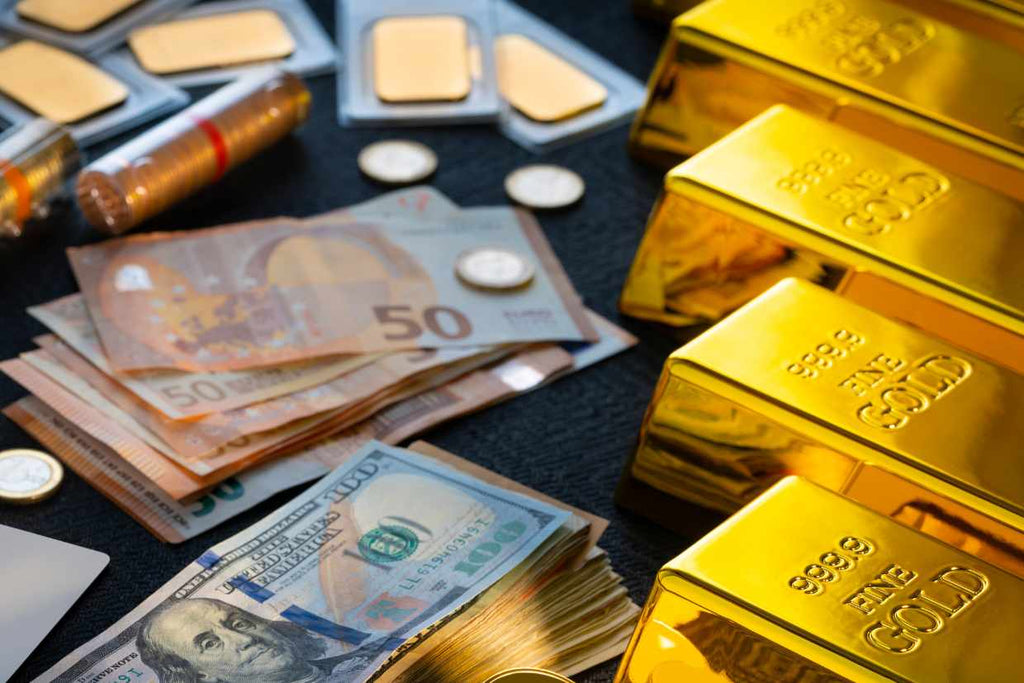
It is a rare metal to be found. When you add the industrious and vigorous mining and extraction process followed by the creating, designing and finishing of the final product, the value skyrockets even more.
However, with all the good things that this precious metal has to offer, the price it comes with is easily justifiable. Besides being easy on the eyes, it proves to be a great investment which goes far beyond everyday jewellery. Based on your requirement and interest in investment, you can choose to go for one or more options below for this precious metal.
- Gold Jewellery : rings, anklets, necklaces, crowns, pendants, bangles etc.
- Physical gold: Gold bullion [bars, coins, ingots]
- Stocks
- Gold saving account
- gold futures
- Gold exchange-traded funds
Essentially, the spot price is constant no matter where it is, meaning the current price of an immediate buying or selling. However, the general price fluctuates with the market trends and depends on the country you make your purchase from. This occurs due to the various government taxes and other import processes, which add and deduct the original price of the product that comes into the market.
If you are looking to invest and add diversity to your portfolio, you might want to consider which country you would choose. Some of the cheapest countries to buy this exquisite metal are Hong Kong, Singapore, United Arab Emirates, the United States, Switzerland, Australia, Canada and India.
It is predicted that there is a possibility that this precious metal will rise in value hence in the price in the market as well, by the end of 2023. Therefore, if you have been fancying the idea of buying some shiny karats, this might be your chance.
So what exactly is Karat?
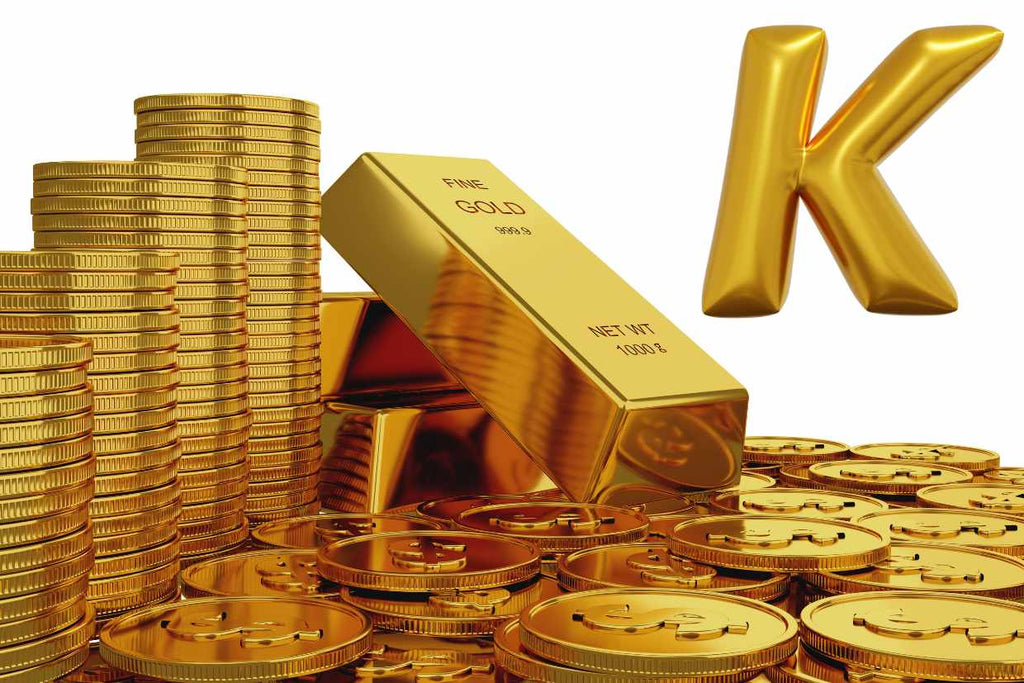
In order to understand the true value of gold, whether it comes in the form of jewellery, coins or bars, you have to be knowledgeable about the measurement of it. Most people are aware that Karat is the standard measurement for this precious rare metal. But what does Karat mean?
Karat refers to the level of purity of the particular gold. The highest purity recorded is 24 karat (24K), which means a 24 karat ring is 99.9% pure gold. Ironically, even though high purity might sound excellent, it is not ideal when it comes to making jewellery because of its low durability. Remember, we said that gold is a soft metal? Well, because of this, gold alloys are mixed with other metal alloys in the manufacturing process to give strength and durability.
Lower karats, such as 22k and 20k, make better damage-resistant jewellery because of the incorporation of other metals. Of course, the lower the karat number, the lower the price. However, most people want to find a good balance between affordable and good-quality jewellery.
For pieces such as necklaces, 22k is a good bargain which ensures a worthy investment if you don't mind spending a little extra, while 18k is the most commonly sold among gold lovers.
Real vs. fake gold.
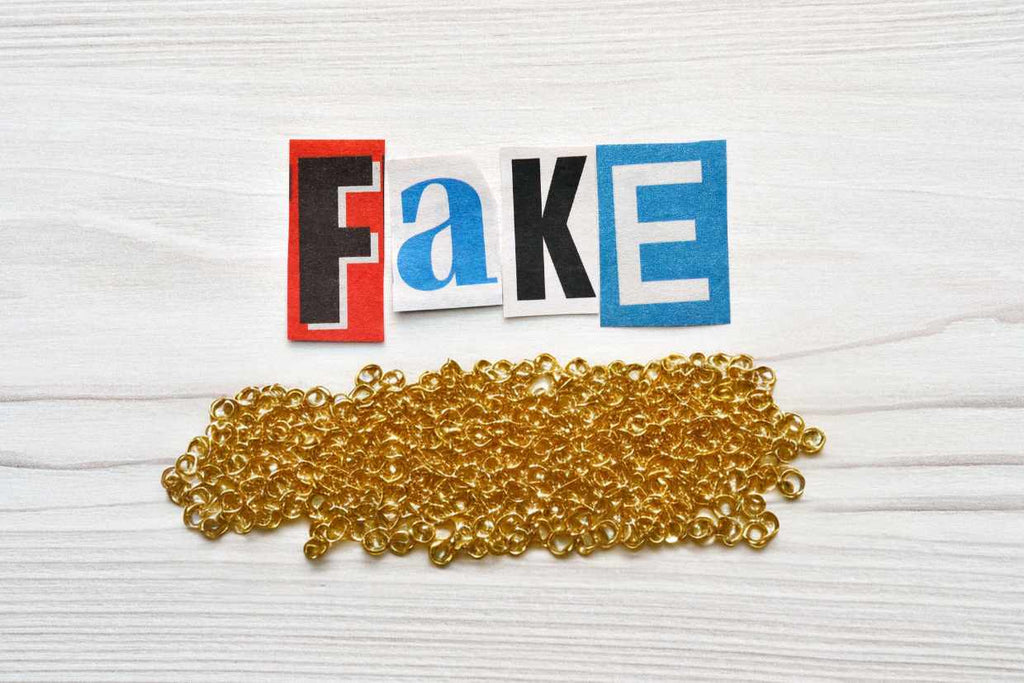
Just like any other, their product on the market, gold, is also counterfeited when selling. This happens more times than you might assume with not just accessories but also products such as coins and bars. Hence, it is absolutely essential that you know how to identify genuine purchases against fake ones. Here are some tips to help you to know what to look for when making an investment.
Search for hallmarks
Hallmarks are a stamp that indicates the genuineness of the gold in the particular product, which ensures the customer is getting their money's worth. In countries like India, China and Singapore, hallmarking is done voluntarily by jewellery manufacturers and sellers to certify that their gold is of a high level of purity and of good quality.
For instance, the SAO hallmarks of the Singapore Assay Office (SAO) guarantee that the specific product is heavily laboratory tested for its purity and quality of the precious metal. You might have seen hallmarks such as 999, 916, and 750 on jewellery, which belong under the same hallmark framework.
Look for these when you buy your jewellery and ensure that your supplier has a reputation for keeping their quality standards and hallmarks, just like in Starlight Jewellery.
Check for letter marking
Ever seen letters such as GP, GE, and HGP while looking to buy real gold jewellery? Well, you might want to look elsewhere if that is the case. These letters mean gold plated, gold filled and heavy gold plated, meaning that actual jewellery is made out of some other metal.
Especially those below 10k karat should be examined for these letters carefully, as the possibility of the jewellery being fake is highly likely.
Look for skin reactions
Most people who have bought disingenuous gold have experienced physical dermal reactions when in contact with a particular piece of jewellery.
You will notice green, blue or brown discolouration on your skin where the jewellery is touched or brushed against if the metal is not gold. Real gold tends to cause skin reactions only in one instance, that is, when you are wearing a liquid foundation and powder.
If you rub the jewellery slightly on your skin where the makeup is applied and blended, you will notice a black pigmentation starting to appear on the foundation. As weird as it sounds, that black colour will confirm what you have in your hand is the real deal.
Metallic tests
You can use other methods to check if the jewellery is made out of genuine precious metal. You can use the below tips and tricks to do your own test.
- Use a magnet and see if the jewellery has a reaction; real gold should not have any visible reaction to a magnet as it is not a magnetic metal in nature.
- Use a small bowl of water to check if your jewellery float; if it does float, it is definitely some other metal.
- Using vinegar; when applied, vinegar will not cause any discolouration on real gold jewellery.
Culturally woven symbolism of gold.
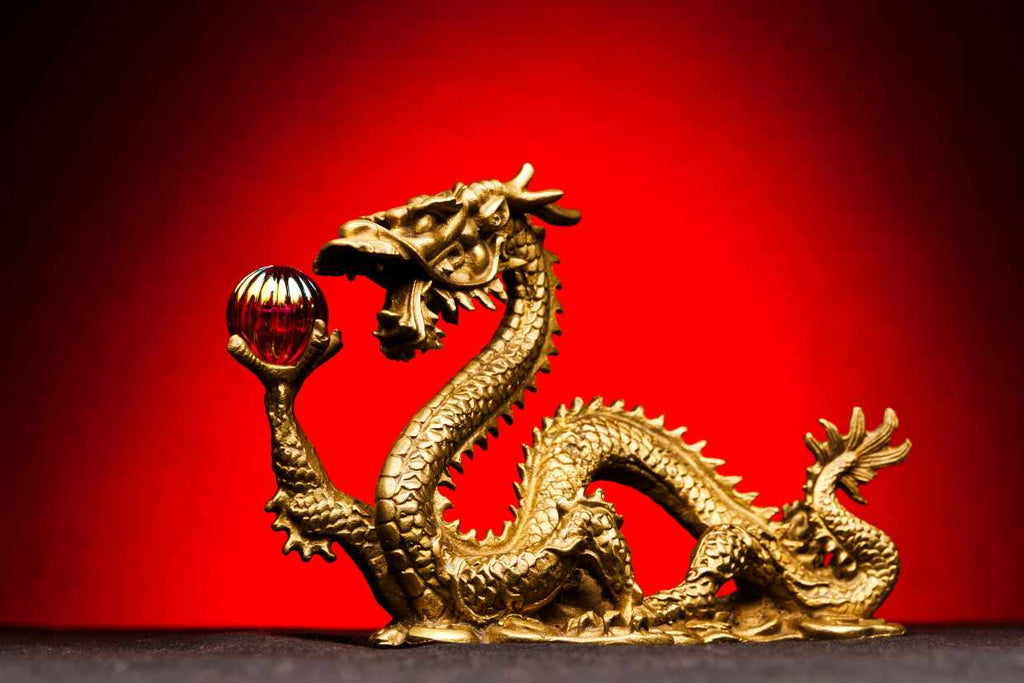
What is gold in cultural contexts?
It has been recognized and adored as more than a priced commodity across many cultures, proudly assimilating this invaluable earth metal with its own unique traditions and rituals. As a result of this, it has become more than a mere metal but rather a priceless symbol of numerous positive associations such as wealth, long life, prosperity, happiness, ever-lasting love and care, intimacy, virtue, good spirits and more.
Numerous gods, deities and higher powers have been recognized and worshipped since ancient civilizations with golden statues or golden symbols, which further confirms that this famous metal has been on a high pedestal for centuries.
This makes gold the perfect gift as it is known to be symbolic of desirable things no matter where you come from.
Influence on the human psychological state
Imagine this for a second...
A hospital room with red walls.
How do you feel? Doesn't feel right, does it?
Thanks to colour psychology, many people are aware of the effect that certain colours can have on an individual's emotions, thoughts, feelings, mood, attitudes and even behavioural interactions. This valuable knowledge is now being utilized to make a lasting impression, set the mood or encourage certain things in a person's mind.
Just like any other colour gold also has the ability to create a mental atmosphere for people who perceive it, which means that you are subconsciously influencing yourself and others when you wear gold jewellery!
According to researchers, it can bring out feelings of serenity, and passion, spread inspiration to try new things with a sense of adventure and can elicit feelings of triumph and achievement. Because it radiates both a strong feminine and masculine energy, wearing gold will do more than just elevate what your wear.
How gold affects your body?

This metal can not only influence your own and others' mental state, but it can also affect the physical metabolism on so many levels. Due to the health benefits gold has to offer, the field of medicine has been using it to treat multiple serious disorders and illnesses, which has been proven to be significantly effective when used the right way.
On top of that, beauty treatments such as gold facials are popular because of the advantages they offer to the client. It can bring a firming effect to the skin while also encouraging new cell growth. It is also known to decrease the breaking down of elastin and collagen, which means you will age much slower!
Moreover, it provides these listed health benefits when worn in the form of gold jewellery.
- Increases immunity and helps your body fight illnesses and infections.
- Keep blood circulation at a prime to promote healthy organs.
- Regulate healthy blood pressure.
- Maintain body temperature and allow internal functions to operate smoothly.
What are the different types?
When you are shopping online, you must have noticed many different types of gold out there while you are adding to your cart. Even though originally, yellow gold took a huge leap in popularity, other various kinds of gold have gotten the same level of obsession within the ever-changing trends.
These diverse ranges of options in the metal offer all precious metal lovers a fighting chance to satisfy their shopping needs that gives a good run for their money.
Yellow gold
When someone mentions gold, this is the type of gold most people will immediately think of in their own minds. That is because this is the classic that is still adored to this day, no matter how long it has been around.
This is the kind that is closest to the real deal in its actual nature when it comes to colour, malleability and composition. However, even though some people might assume that this is the pure metal itself, they would be wrong.
In order to make sure that the final product of jewellery comes out with high durability, all while being visually pleasing, the pure metal is mixed with metal alloys such as copper, silver, nickel and zinc. The signature colour comes as a result of using a higher amount of copper alloy than the zinc and silver alloy.
The Tropical tan of yellow gold is loved by most because of its versatility to match with a range of other accessories and clothes regardless of gender, ethnicity or any other differences. Due to this, this is a rather preferred choice for sentimental jewellery such as engagement rings, wedding rings and custom gift jewellery.
White Gold
This is a rather modernized version of the classic precious metal that everyone admires.
When first invented, it was just to replace the gaps in the demand for highly-priced yellow gold. It allowed for a wider range of customers of shiny metals to invest and enjoy accessorizing their wardrobes after World War II.
Even though, at first glance, it might look like silver, don't be fooled. White gold is, well..more whitish than silver. Silver jewellery would have a blue-grey hue compared to this.
Unlike other types of this precious metal, white gold jewellery comes with an extra protective coating from the finishing process. The coating is done using a metal called rhodium which protects the jewellery from tarnishing and guarantees a long life while being extra shiny.
Be that as it may, this tends to be slightly more expensive than other types of gold in the jewellery market because rhodium is a comparatively expensive metal.
Even though the protective layer makes the jewellery longer-lasting, once the coating eventually wears off, re-coating is needed to preserve the appeal and the quality of your purchase. You can take it to your jeweller, who will easily put a new rhodium finish on your valuable jewellery.
Rose Gold
This is another tasteful rendition of the classic precious metal that gives a unique personality to the wearer. This is made from the alloy combination of yellow gold mixed with copper and silver metals. The ratios in the alloy recipe will affect how rosy the final product appeals to be.
Simply, if the manufacturer uses a higher amount of yellow gold, the jewellery would turn out with a weaker pink hue, while if they decided to use a higher amount of copper metal in the mix, the jewellery would take a deeper hue of the signature pink.
This has become a beloved sensation, especially among the younger generations compared to older generations, due to its youthful and playful nature. The blush-beige undertones complement both warm and cool tones in clothes; therefore, you can easily pair this jewellery with any outfit you would like.
Similar to yellow, rose gold does not have an extra coating of rhodium or any other different metal. Nonetheless, it is more durable and lasting than other types of gold out there. Therefore this makes a better fit for you if you are looking for jewellery for everyday wear but not sure what exactly to pick.
Conclusion
Now that you are aware of what gold is and so many aspects attached to it, you can go buy that necklace you have been wanting or get that cute bracelet as a sentimental gift to your loved one without worrying about things you did not know before.
Gold comes from a long way, from the mining sites on this earth to your hand after going through layers and layers of labour, which pushes it to the perfection it is. The numerous trends in precious metals will keep changing faster than waves kiss a shore and roll back to the ocean; however, timeless trends such as gold always remain.
Remember not to get dazzled by the shine, and always make sure to check the hallmarks and other indicators when you purchase to ensure a worthwhile investment that adds vibrance to your wardrobe and makes you feel beautiful and confident inside out.
Sources
https://www.usgs.gov/faqs/how-much-gold-has-been-found-world
https://www.investopedia.com/articles/economics/09/why-gold-matters.asp
https://www.kuberbox.com/blog/how-is-my-gold-jewellery-made/
https://www.gold.org/about-gold/about-gold-jewellery/gold-hallmarks
https://dsfantiquejewelry.com/blogs/journal/mankinds-fascination-for-gold-how-do-different-cultures-see-gold